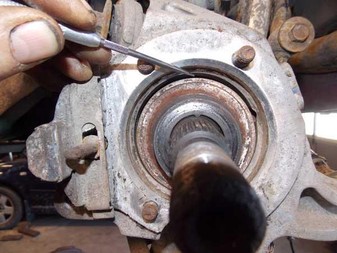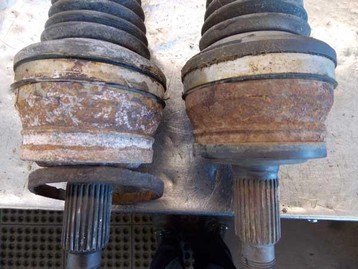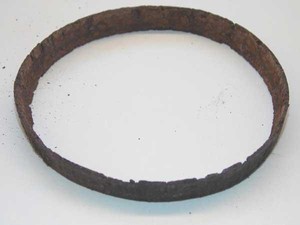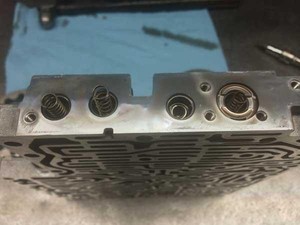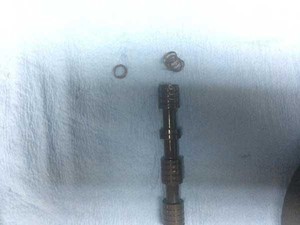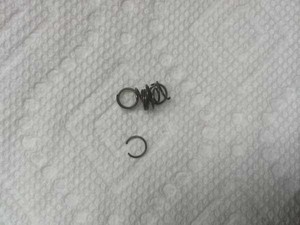Nixing Nag 1 Problems
We have written several articles about the NAG 1 five-speed automatic transmission used in Dodge, Chrysler and Jeep vehicles. It comes in both two-wheel drive and four-wheel drive configurations and may also be referred to as the WA580, W5A580, 5G-Tronic or 722.6 transmission. This article will continue with some additional issues that may show up in your shop.
A good friend and meticulous rebuilder, Dale Desveaux, owns and runs a shop in Napanee, Canada. He had a 2007 Chrysler 300 3.5L AWD vehicle with the NAG 1 unit come in to his shop. It exhibited a no up-shift condition and was unable to get speeds over 15 mph due to a loss of power from the engine.
He attached a scan tool and pulled the following codes:
- P0501: Vehicle Speed Sensor 1 Performance — this code will set if multiple ABS wheel speed signals are invalid.
- U140A: Implausible Right Front Wheel Speed Signal Received — readings compared at 25 mph
- C101F: Right Front Wheel Speed Comparative Performance — different signal compared to others.
- U140B: Implausible Left Rear Wheel Speed Signal Received — readings compared at 25 mph
- C102A: Left Rear Wheel Speed Comparative Performance — different signal compared to others
- C121A: Steering Angle Sensor Not Initialized — refer to C1231 Drive Test Steering Angle Sensor
Vehicle Speed
This particular transmission does not utilize a traditional output speed sensor for a vehicle speed signal. The ABS system converts wheel speed signals (specifically the rear wheel speed signals) into a vehicle speed that is then broadcast over the network. The TCM receives this signal and utilizes this information for shift scheduling and gear ratio calculations, among other things.
Since vehicle speed is coming from the rear wheel speed sensors, there are a number of items to consider if gear ratios are wrong. One obvious cause of incorrect gear ratios is a slipping transmission, and for many reasons of its own. But the not-so-obvious reasons, which can easily be overlooked, would be the use of a transmission with incorrect planetary gear ratios, the installation of an incorrect rear differential, a TCM misapplication or an incorrect pinion factor that was performed.
But getting back to the 2007 Chrysler 300 3.5L AWD vehicle, the front- and rear-wheel speed signals are used together for ABS/Traction Control, Electronic Stability Control (ESC) if so equipped, AWD control, and for corner assessment (curve recognition).
What does this mean?
What this basically means is that all four-wheel speed signals are used to determine if the vehicle is in a turn. The rpm signal will be lower for the inside wheel speed and higher for the outer wheels. Once this is seen, the TCM is commanded to hold the gear going into the turn to prevent shift busyness as the driver is going in and out of the throttle and braking on the turn. This also explains why different tire sizes on the vehicle will negatively affect shift scheduling. This typically results in late up-shift with sensitive kick-downs or no up-shifts at all as the computer thinks the driver is in a turn while he or she is actually driving straight.
An interesting aspect to this strategy is how the ABS system compares wheel speed signals to the steering angle sensor, verifying a turn is indeed taking place. One would think that a steering angle sensor code would appear if the wheel speed signals are indicating a turn while the steering angle sensor does not. This we have not seen on our technical help line. But what we have seen is when there is a total loss of wheel speed signals, a steering angle sensor code will set, as did with this Chrysler 300.
Code List
Looking at the code list, one rear wheel speed signal was lost, as well as one front wheel speed signal. This takes out any possibility of the ABS Module being able to determine if the vehicle is in a turn, which ultimately affects curve recognition strategies. This also caused a conflict with the data from the steering wheel angle sensor prompting the ABS Module to set code C121A.
Chrysler information says DTC C121A “may” set with DTC C1231 because of the ABS Module detecting implausible steering angle sensor data. Although this code did not set, C121A pointed us to look at C1231. The information provided by Chrysler for this code breaks down and defines three performance problems that could cause this code to set — an erratic performance problem, a comparative performance problem or an angle over-travel performance problem (C1219, C123F C1240). Possible causes listed were a steering angle sensor installation problem, a faulty steering angle sensor or an ABS Module problem. With the steering wheel angle sensor being original to the vehicle, it eliminated an installation issue. It was also determined that Code C121A set only after it lost the two-wheel speed signals, which suggested an ABS issue rather than an angle sensor problem.
| In short, it was quickly determined that steering angle code C121A was most likely the result of a loss of wheel speed signals. This made looking at the loss of wheel speed signals a priority in the diagnostic process. An interesting point to be made here is that the vehicle speed produced by the ABS Module, which is given to the TCM over the network, is calculated from the two rear-wheel speed signals, not from all four-wheel speed signals.
|
With that said, the loss of one rear-wheel speed signal was the primary cause of the no up-shift complaint. By getting the rear-wheel speed signal back, the transmission should begin to shift. The speed sensor wiring is encased, making it very difficult to check the signal with a scope near the sensor itself. It would require having to slice open the encasement, so it’s best to check the signal at the TCM. However, Dale noticed that the encased left rear-wheel speed sensor wiring was long enough to cross over and reach the right rear wheel. For a quick diagnostic procedure, he pulled out the right rear-wheel speed sensor and poked the left rear-wheel speed sensor in its place. While on the lift, wheels off the ground, he ran the vehicle in gear using a scan tool view of the left rear wheel speed signal parameter
| The idea here is that if there was not a signal, the sensor or wiring will need to be inspected. If there is a signal, nothing is wrong with the sensor or wiring. This would point to a malfunction of the left rear exciter ring, preventing the sensor from producing a signal. And that is exactly what happened to Dale. He had an excellent reading so he pulled the axle to inspect the sensor ring and did not find one. With it being difficult to see what the sensor is reading to excite it, he changed the wheel bearing, as some vehicles have the pickup ring as an integral part of the bearing. Unfortunately, this did not resolve the problem. At this time he decided to pull the right rear axle and discovered that the sensor ring in this application is located on the end of the axle. Evidently, due to corrosion, the sensor ring had separated from the axle and became fixed to the housing. |
| Once Dale replaced the axle with a sensor ring, it resolved the no up-shift complaint and the lack of power complaint. The lack of power felt like a faulty accelerator pedal position sensor or throttle body. This was an unexpected surprise as the definition for code P0501, U140B or C102A never once mentioned that it will affect engine power as some a form of failsafe. Nevertheless, codes P0501, U140B, C102A and C121A were eliminated and the loss of power complaint was resolved. It was a gift readily accepted! All that was left was to fix the front-wheel speed signal, which would eliminate the remaining codes and restore curve recognition strategies. |
| Another entirely different problem that comes up is the setting of code P1731. The code definition is nothing more than “Incorrect Gear Engaged.” It can be quite an elusive code to diagnose, as there are many possibilities that can set this code. This code may also cause the transmission to failsafe to neutral depending upon the type of failure the transmission has. |
| The theory behind P1731 is that the TCM compares the calculated gear with the gear the transmission has actually engaged. The actual gear is identified by verifying the signals of the two input speed sensors 1 (N2) and 2 (N3), as well as the transmission output speed (from the ABS system). If the actual gear differs from the gear calculated by the TCM, the TCM value is adjusted to the engaged gear and a counter is increased by 2 points. If after a shift the engaged gear and the calculated gear still match, the counter is decreased by 1 point. A DTC is detected as soon as the counter exceeds a threshold. |
| The TCM offers a parameter of shift time for each of the shifts that take place. Looking at this parameter through a scan tool may provide a clue as to which gear is being problematic. In one sense, without having the ability to look at shift time parameters, identifying the cause of the problem is like trying to find a needle in a haystack. But sometimes the way in which the code sets can be a clue in itself.John Parmenter, a well-respected tech who owns a shop in Centereach, Long Island, and is also a tech advisor for Precision International, ran into a 2006 Jeep Commander with this code. The vehicle shifted well through all the gears, except for a slight tie up on the four to five shift. Code P1731 would set after three drive cycles. With it taking three drive cycles to set the code along with actually feeling a slight bind up going into fifth gear, John suspected a valve body issue. |
An interesting feature with the NAG 1 transmission is what’s called “Shift Groups.” There is a dedicated solenoid and a set of valves for each specific shift making up the contents of the group. There is the 1-2/4-5 shift group, a 2-3 shift group and a 3-4 shift group. With the 1-2 shift functioning well, the 1-2/4-5 shift group seemed to be an unlikely possibility. What John chose to do was to inspect the 3-4 shift group. What he discovered was a broken spring for the 3-4 Shift Pressure Valve as seen above. This prevented the proper release of the K1 clutch as the B1 clutch was being applied.
One other way that could point you in the right direction would be to clear the code and drive the vehicle, shifting it through each gear manually. Most of these vehicles have paddle shift or shift levers with tip-up, tip-down features that allow you to manually shift into each gear. The tip here is to hold each gear for longer than usual to see when a code sets, pointing you to the problem area.
Was this article helpful? Like, share and comment below if it was. Don’t forget to visit our bookstore for the most comprehensible and sought after tech manuals in the industry.



